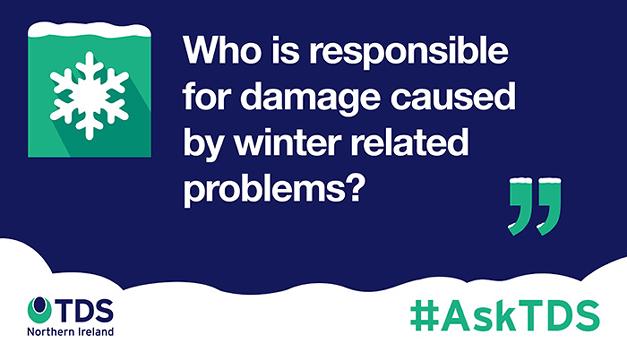#AskTDS: “Who is responsible for damage caused by winter related problems?”

In this week’s #AskTDS blog, we answer the question: “Who is responsible for damage caused by winter related problems?”
As we enter the colder winter months, we look at who is responsible for winter related problems and how to avoid them. As temperatures drop, it is important for tenants and landlords to be aware of each other’s responsibilities.
Landlords should check that properties are sufficiently insulated: that heating systems are working adequately to cope with any decreases in temperatures. A record of a winter check and information provided to tenants advising on precautions to prevent any possible issues will help tenants understand their responsibility. This will include using the property’s heating system correctly and heating property during cold spells; tenants and landlords do not want burst pipes or damage to the property occurring during winter period as it causes all parties inconvenience and added problems. If the property is left vacant, tenants should continue to heat the property sufficiently to prevent burst pipes. These responsibilities can be set out in the tenancy agreement from the beginning of the tenancy.
The winter check should not only include the heating system but also include checks to internal and external pipes to ensure that are properly insulated, and that external drains and guttering are cleared. Internal checks for mould, damp and condensation, as well as providing guidance to tenants on how to prevent these issues occurring during winter months can help prevent any future potential disputes.
The winter check provides the landlord and tenant the opportunity to agree the condition of the property and set out responsibilities which helps to manage each parties’ expectations of tenancy. If all parties are in agreement on the condition of the property and the responsibilities of each other’s role in maintaining the property, this will help to reduce any difficulties at the end of the tenancy.
TDS Northern Ireland provides guidance and information available to tenants and landlords on the website on all aspects of tenancy deposit protection and the dispute process, including how to resolves disputes. These guides can help resolve any potential issues and provide for a smooth tenancy process.
Our guides and information can be found here: https://www.tdsnorthernireland.com/tools-and-guides/
About TDSNI:
Tenancy Deposit Scheme Northern Ireland (TDSNI) is a government-approved scheme for the protection of tenancy deposits; TDSNI offers both Insured and Custodial protection and also provides fair adjudication for disputes that arise over the tenancy deposits that we protect.
TDSNI Insured Scheme: where a TDSNI member can hold the tenancy deposits as stakeholder during the term of the tenancy.
TDSNI Custodial Scheme: where TDSNI hold the deposit for the duration of the tenancy.
TDSNI Academy: TDSNI provides property professionals with invaluable training in tenancy deposit protection and tenancy deposit disputes.
TDSNI can only comment on the process for our scheme, other deposit protection schemes may have a different process/require different steps. Content is correct at the time of writing.
ARLA Propertymark: For agents who would like to stay up to date, you can contact Propertymark | ARLA at: join@propertymark.com. By being a member of Propertymark | ARLA you will be eligible for TDS Insured best headline rates.
